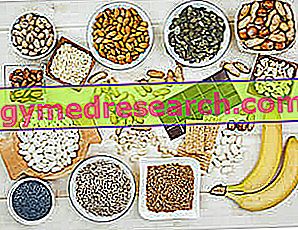Premise
Only a minor fraction of magnesium taken from foods and supplements is actually absorbed by the human intestine; to give an idea, we are talking about a percentage between 10 and 50%.
The amplitude of this range is explained by the numerous factors that can influence the absorption of magnesium.
Magnesium deficiencies
Magnesium deficiency seems to offer an important contribution to the onset of various diseases: heart and vascular diseases (ischemic heart disease, cardiac arrhythmias, hypertension, atherosclerosis), osteoporosis and asthma.
Magnesium deficiency has also been related to dysmenorrhea and premenstrual syndrome.

In the picture: Some of the richest magnesium foods
According to some surveys, subclinical magnesium deficiencies would involve about 70% of the western population, both male and female; consequently, knowing the factors that can favor (or hinder) the absorption of magnesium is very important.
NOTE: A subclinical deficiency is a slight deficiency, not sufficient to trigger the classic deficiency symptoms, but still potentially implicated in the onset of various disorders.
In other words, for many people the dietary intake of magnesium is sufficient to avoid a condition of deficiency (hypomagnesemia), but it does not allow to establish a normal plasma concentration that is protective against various pathologies.
How Absorption Happens
The absorption of magnesium occurs at the intestinal level, from the duodenum (initial tract of the small intestine) to the colon (large intestine). As an indication:
- 40% of the magnesium taken up is absorbed in the small intestine, especially in the intermediate and distal sections (jejunum and ileum);
- 5% of magnesium is absorbed in the large intestine;
- 55% is lost with faeces.
As mentioned in the introductory part, these variables are still indicative and in some cases the overall absorption percentage can be even lower than 20%.
However, before being absorbed, magnesium must be "separated" from the substances to which it is bound; this passage takes place at the gastric level thanks to hydrochloric acid (not surprisingly, patients taking proton pump inhibitors are exposed to a greater risk of hypomagnesemia).
Magnesium absorption can exploit two mechanisms:
- passive diffusion: transfer of magnesium from the point of greatest concentration to that of minor concentration, exploiting specific "channels" (paracellular proteins of tight junction TJ).
- facilitated diffusion: involves a specific transport protein (abnormal channel proteins TRPM6 and TRPM7) that "draws" magnesium in the apical portion and transports it to the basolateral portion of the enterocyte, from which it passes into the interstitial fluid and from there to the blood.
The facilitated diffusion mechanism, typical of the colon, is
- saturable (since the availability of carriers has a limit)
- inducible (the synthesis of these transporters increases in conditions of magnesium deficiency, that is when the food supply is scarce and the organism does not have sufficient reserves).
Once the mineral has been absorbed in the intestine, the task of regulating the body's reserves of magnesium is mainly entrusted to the kidney, which acts on the quantity of the mineral excreted in the urine, exploiting mechanisms similar to those just described for the intestine.
Magnesium homeostasis in the human body depends on the balance between intestinal absorption and renal excretion (and resorption).
Low plasma concentrations of Mg2 + induce greater intestinal absorption and less renal excretion, while high plasma concentrations of Mg22 + lead to inhibition of reabsorption in the distal convoluted tubule (renal recovery mechanism).
A small amount of magnesium is lost through sweating.
The bones contain more than half of the body magnesium and, if necessary, it is also possible to draw on this "reserve" favoring the mobilization with respect to the deposition.
Magnesium absorption contained in supplements
In general, supplements containing organic magnesium salts
such as magnesium lactate, magnesium citrate, magnesium succinate, magnesium aspartate, magnesium glycinate, magnesium taurinate, magnesium diglycinate, magnesium fumarate, magnesium ascorbate etc.
they are absorbed in higher percentages than the supplements based on inorganic magnesium salts:
such as magnesium chloride, magnesium carbonate,, magnesium oxide, magnesium sulfate etc; among these, magnesium chloride has shown the best bioavailability, thanks to its remarkable solubility in water. In fact, at a general level, we have seen that as the solubility in water of a magnesium salt increases, its bioavailability also increases.
Unfortunately, in the literature there are rather contrasting data regarding the absorption percentages of the various magnesium salts; therefore it is not possible to provide more specific and detailed information.
According to some studies, only 4% of magnesium taken in the form of magnesium oxide would actually be absorbed, while for organic salts the percentages absorbed would be 2-3 times greater, in the order of 8-12%.
Factors that reduce absorption
As for food, it is known that magnesium absorption is reduced by:
- FOOD FIBERS: especially those insoluble, non-fermentable (contained in bran and whole grains)
- OXALATES: anti-nutrients found in spinach, green leafy vegetables, tea, coffee and cocoa;
- SLICES: anti-nutrients present in whole grains and in the skin of legumes.
Attention : what has been explained above can lead to misinterpretations, given that among the foods with the highest magnesium content are those foods - such as green vegetables, oily nuts, legumes, chocolate and whole grains - high in fiber and / or oxalates and / or phytates.
For this reason, these foods must absolutely not be removed from the diet, either because they are a precious source of magnesium, or because they provide other very important micronutrients.
The soaking of legumes and whole grains before cooking, the consumption of sprouted seeds and the cooking of foods rich in oxalic acid (such as spinach), increase the bioavailability of the magnesium they contain.
Other factors that can decrease magnesium absorption:
- CATIONS: the excess of one or more cationic minerals (such as manganese, potassium, calcium, iron, zinc, phosphorus and copper) in the same meal, can reduce the absorption of magnesium forming insoluble aggregates.
- DAIRY PRODUCTS and COLA type drinks: the association of foods rich in calcium (such as dairy products) and / or phosphorus (contained in carbonated cola-type drinks) with foods rich in magnesium or magnesium supplements should be avoided in particular. Therefore, regular consumption of cola-type drinks at meals exposes the subject to greater risks of magnesium deficiencies.
- EXCESS FATS at the same meal, due to the saponifying action on magnesium.
Other factors that can reduce absorption or increase magnesium losses are:
- SOME DRUGS: antibiotics (tetracycline, gentamicin), proton pump inhibitors, antacids, neuroleptics, salazopirin, diuretics (furosemide, thiazides), chemotherapy (cisplatin), laxative abuse.
- CERTAIN CONDITIONS OF HEALTH: reduction of gastric acidity, alcohol abuse, celiac disease, Crohn's disease, kidney disease, diarrhea and vomiting, diabetes, malabsorption syndromes, steatorrhea and pancreatic insufficiency;
- NATURAL DIURETICS: tea, coffee, energy drinks, other caffeine-based drinks and herbal preparations with diuretic action, tend to increase the urinary excretion of magnesium;
Factors that favor absorption
As for food, the absorption of magnesium can be favored by:
- FRUCTOSE AND COMPLEX CARBOHYDRATES
- ANIMAL PROTEINS
- TRIGLICERIDES WITH MEDIUM CHAIN
- SOLUBLE OR FERMENTAL FIBERS
- VITAMIN D (in association with parathormone)
Conclusions
Although it is not possible to identify, as in the case of iron, unambiguous and well-defined recommendations to improve the absorption of magnesium, we can however draw up some basic recommendations to ensure an adequate supply of magnesium:
- consume adequate quantities of fresh fruit (400-600 g / of, mainly in secondary meals) and vegetables (100-200g, both at meal and at dinner)
- better to boil spinach before consumption
- prefer whole grains to refined, at least 50% of meals
- limiting (or rather avoiding at all) the consumption of carbonated drinks containing phosphorus (cola type), especially with meals
- secondary meals can be structured alongside the consumption of fresh fruit, small quantities of oily dried fruit (10-15g of almonds or walnuts or hazelnuts etc.)
- avoid binges and the excessive variety of dishes consumed in the same meal;
- those who consume large quantities of dairy products, those who follow a diet low in fresh fruit and vegetables, or make a wide consumption of drinks containing phosphorus, such as coca-cola, should seriously evaluate the regularization of their food style and / or the use of one specific magnesium supplement. The same is true for patients who take drugs or are suffering from diseases that can reduce magnesium levels in the body; in these circumstances a preventive medical consultation becomes mandatory.



